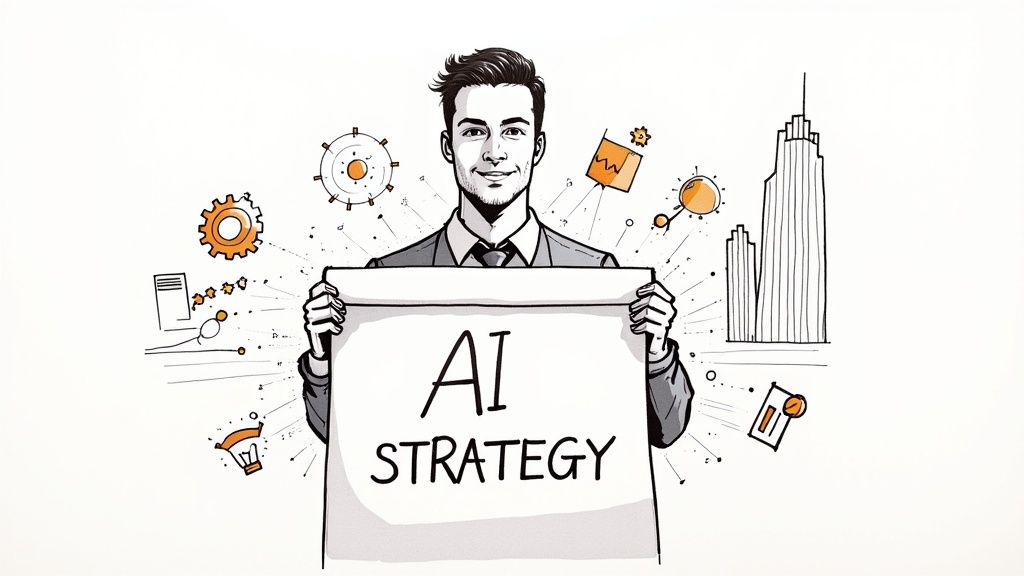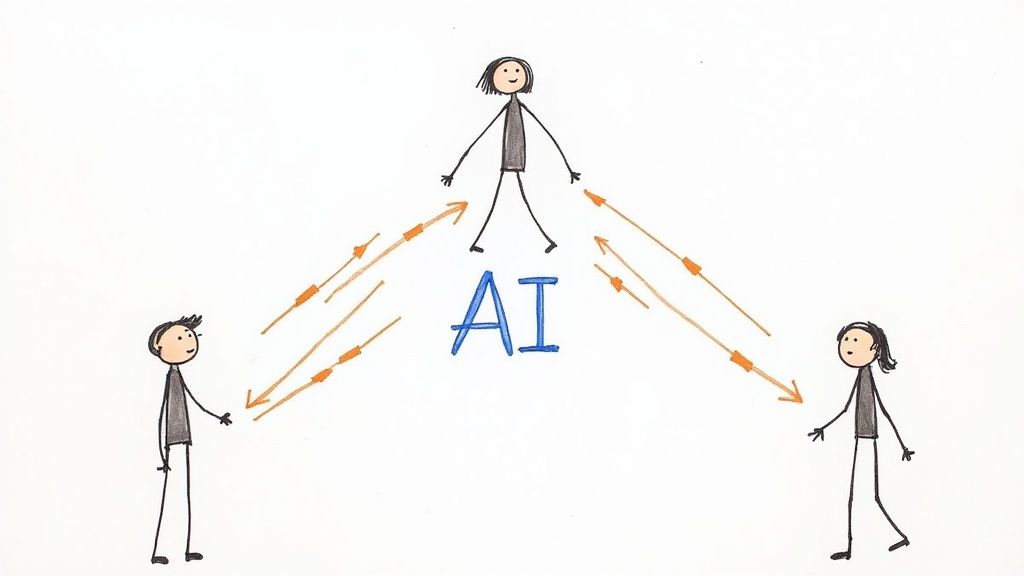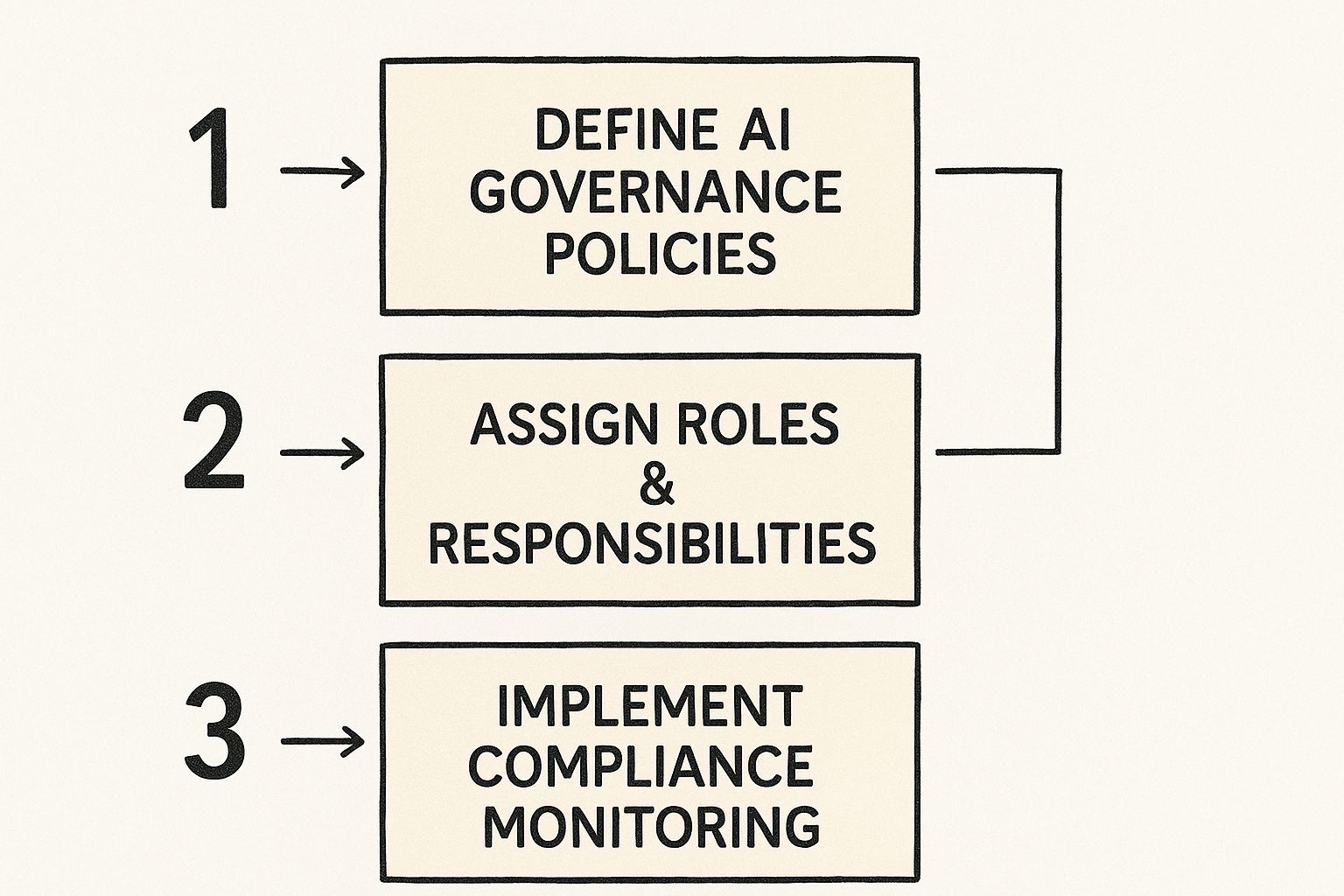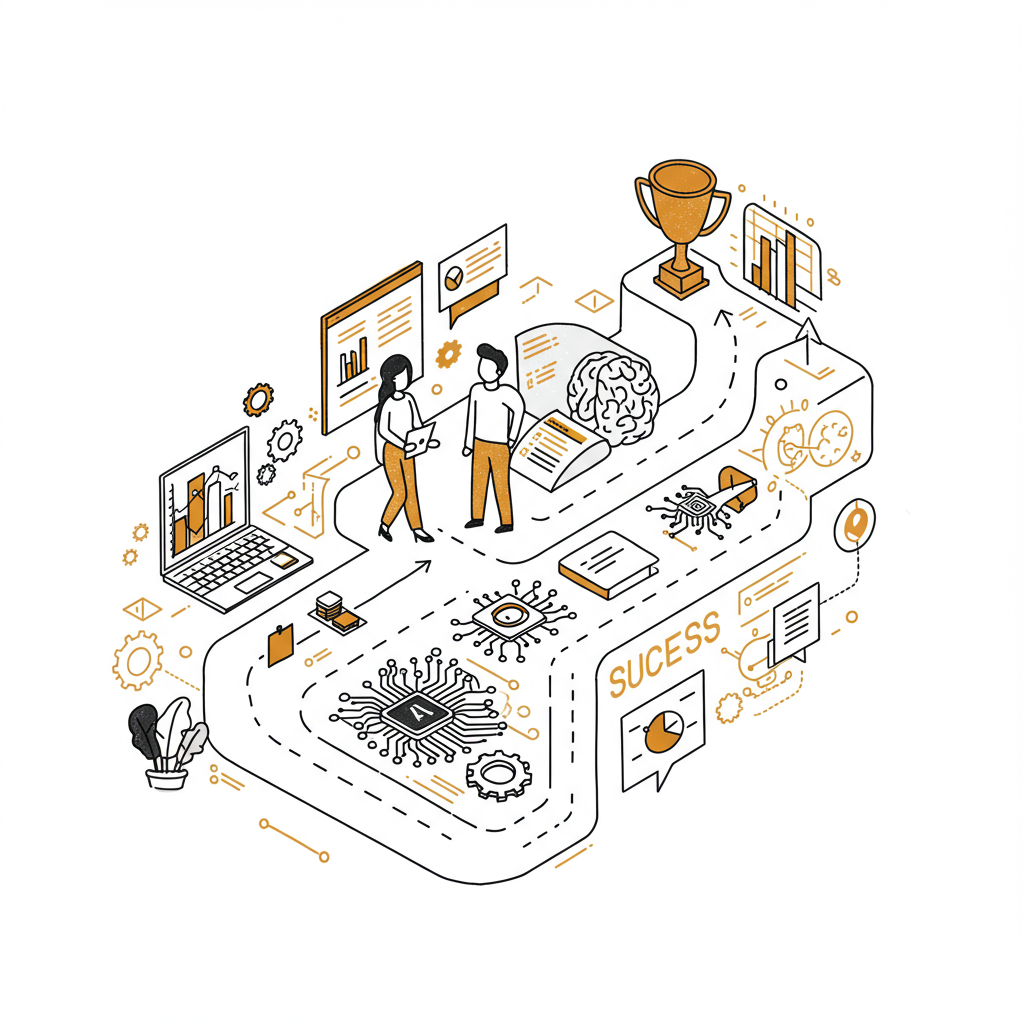Building AI Adoption Strategies for Enterprises That Drive Success
Learn how building AI adoption strategies for enterprises can transform your business. Discover expert tips to implement effective AI solutions today.

Before you even think about deploying a single AI tool, you need a blueprint. A real, comprehensive strategy is the bedrock of successful AI adoption in any large company. It's about meticulously tying every AI initiative back to core business goals, getting leadership genuinely excited, and preparing your entire organization for the shift. This isn't just bureaucratic paperwork; it’s the difference between a few scattered, disconnected experiments and building a powerful engine for real business growth.
Laying the Groundwork for Enterprise AI Success
It’s tempting to jump on the AI bandwagon. I’ve seen it happen time and again: companies, driven by hype, start deploying AI tools in isolated departments. The result? A mess of fragmented efforts, duplicated work, and results that are, frankly, underwhelming.
A winning strategy has less to do with the specific technology and more to do with the foundational work you do before you start. For any large organization looking to get real, long-term value from AI, this initial phase is non-negotiable.

The numbers don't lie—the gap between a planned and an ad-hoc approach is massive. Recent data shows that enterprises flying blind without a formal AI strategy report a dismal 37% success rate. Now, compare that to companies with a well-defined plan: they're seeing an 80% success rate. That's more than double the effectiveness.
The same study, however, reveals a critical challenge: 72% of senior executives point to fragmented AI efforts as a major roadblock to achieving any cohesive impact. This just drives home how risky an uncoordinated approach really is. You can learn more about these enterprise AI adoption findings to see the full picture. The data clearly shows that a structured plan is your best defense against siloed projects and internal friction.
To put this in perspective, let’s look at the tangible differences in outcomes.
Strategic vs Ad-Hoc AI Adoption Outcomes
The table below contrasts the typical results for enterprises that invest in a formal AI strategy against those that take a more fragmented, ad-hoc approach, based on recent survey data.
Metric
With Formal AI Strategy
Without Formal AI Strategy
Project Success Rate
80%
37%
Revenue Growth from AI
Achieves significant, attributable growth
Minimal to no measurable impact
Operational Efficiency
Reports major gains across business units
Small, isolated improvements
Data Governance
Centralized and robust
Inconsistent and often non-compliant
Employee Adoption
High engagement and skill development
Low adoption, confusion, and resistance
The contrast is stark. A strategic approach doesn't just improve success rates; it fundamentally changes the value an organization can extract from AI across the board.
The Core Components of a Robust Strategy
So, where do you start? It begins with a unified vision. This often comes to life through collaborative processes like AI co creation, which helps transform AI from a buzzword into a shared goal. But that vision needs support. It rests on a few critical pillars:
- Executive Sponsorship: You need more than just a signature on a check. C-suite leaders must become true champions for the AI vision, communicating its importance and keeping it a top priority across the entire company.
- Cross-Functional Alignment: AI can't live in the IT department. You have to bring leaders from operations, finance, marketing, and other key areas to the table. This ensures every project is grounded in a real business need and has the support to succeed.
- AI Literacy and Education: Your people need a baseline understanding of what AI can (and can't) do. Widespread education demystifies the tech and, more importantly, empowers employees to spot valuable use cases in their day-to-day work.
"A key lesson in years of academic research in management has shown us that culture eats strategy for breakfast. If you don’t understand the cultural aspects—the organizational aspects of change—then your best strategies will just simply not work."
From Blueprint to Business Value
Think of your strategy as the constitution for your AI journey. It sets the rules of engagement for everything that follows, from picking the right pilot projects to measuring their impact.
By defining clear objectives and governance from day one, you build a framework that helps everyone make smarter decisions. It stops teams from chasing shiny new objects that offer little value and focuses your precious resources on initiatives that will actually move the needle.
This foundational work is what separates the dabblers from the innovators. It’s how you go from merely experimenting with AI to truly weaving it into the fabric of your operations. Investing in this early planning phase through services like AI strategy consulting can provide the structure and outside expertise needed to start your journey on solid ground.
Connecting AI Initiatives to Core Business Goals
Let’s be honest: the most sophisticated AI tool on the planet is a waste of money if it doesn't solve a real business problem. I've seen too many companies jump on the AI bandwagon just for the sake of it, only to end up with a hefty bill and a team wondering what the point was.
The real art of a successful strategy is drawing a straight line from AI's capabilities to your core business objectives. This is what separates the hype from the actual results. It ensures every project has a clear purpose and, just as importantly, a measurable impact on the bottom line. You stop chasing shiny new objects and start focusing on initiatives that deliver the highest ROI or lock in a competitive edge.

From Business Problems to AI Solutions
The journey shouldn't start with, "What cool things can we do with AI?" That’s a recipe for expensive science projects. Instead, the question you need to ask is, "What are our biggest business headaches right now?" This simple flip in perspective is critical; it grounds your entire effort in what actually matters.
A fantastic way to tackle this is by looking at it from two angles at once: top-down and bottom-up. Your leadership team knows the high-level strategic mountains you need to climb, while your frontline teams are in the trenches, acutely aware of the daily friction points that AI could smooth out.
- The View from the Top: The C-suite might set a goal to cut customer churn by 15% or boost operational efficiency by 20% this year. These are the North Star metrics that should guide any major investment.
- The View from the Trenches: A customer service manager knows their agents are bogged down, spending 40% of their time just manually logging call details. That’s a specific, tangible problem you can throw AI at for an immediate win.
When you bring these two perspectives together, you find the sweet spot where AI projects are both strategically vital and practically useful.
Identifying High-Impact Areas
With a list of potential problems in hand, the next step is to figure out where AI can pack the biggest punch. Not all business functions are created equal when it comes to AI's potential. Zero in on the areas that have a direct line to your revenue, costs, or customer happiness.
Think about these high-impact domains:
- Operations and Supply Chain: This is often a goldmine. AI can optimize shipping routes, predict when a machine on the factory floor will need maintenance, and automate inventory, all of which leads to massive cost savings.
- Customer Support: AI chatbots and virtual agents can handle the flood of common questions, which frees up your human experts to tackle the truly tricky issues and dramatically slash response times.
- Marketing and Sales: Imagine personalizing every customer's journey, accurately predicting sales trends, or automating lead scoring. That’s how AI drives higher conversions and top-line growth.
A piece of advice I always give: start with projects that can deliver clear, undeniable wins. These early successes build crucial momentum and make it far easier to get the green light for more ambitious, long-term bets down the road.
Prioritizing for Maximum ROI
You'll inevitably end up with more great ideas than you have resources to pursue. This is where prioritization turns your wish list into an actionable roadmap. A simple value vs. feasibility matrix is a powerful tool here. Just plot your potential projects on it.
This visualization makes the trade-offs crystal clear, helping you focus on the most promising opportunities. The "quick wins" are those low-effort, high-impact projects that build confidence across the organization. The "strategic initiatives" are bigger, more complex beasts, but they're the ones that offer game-changing long-term value. This entire process is a central part of building a coherent AI strategy framework.
By tying every single AI initiative back to a core business goal, you stop treating AI like a costly experiment. It becomes a predictable and powerful engine for growth—and that’s what separates the companies that just use AI from the ones that truly win with it.
Designing a Practical AI Adoption Roadmap
A great AI strategy isn't a single, all-or-nothing leap. It's a journey you take in stages, starting small and building up. Think of it as moving from controlled experiments to a full-blown, enterprise-wide integration of AI. This approach lets you prove the value early, get people excited, and secure the backing you need to keep going.
The first step is all about the proof of concept. You need to kick things off with pilot projects designed to score some quick, tangible wins. These early successes become your internal case studies, showing skeptical stakeholders that AI is more than just industry buzz—it actually delivers.
Selecting Your First Pilot Projects
Choosing where to start is probably the most critical decision you'll make. You need to find that sweet spot: a project that’s achievable but also significant enough to make people sit up and take notice. The key is to identify a few real-world use cases with high impact but low complexity. This lets you showcase AI’s potential without needing a huge budget or a massive overhaul of your current systems.
Be specific about what success looks like. Instead of a vague goal like "improve customer service," aim for something measurable, like "reduce average call handling time by 15%." When you can point to a clear ROI, building a business case for more funding becomes infinitely easier.
Remember, the goal of a pilot project isn't just to succeed—it's to learn. Even a project that doesn't hit every target can teach you priceless lessons about your data, your infrastructure, and where the real organizational hurdles lie.
Securing and Scaling Your Budget
Funding your AI roadmap should follow the same step-by-step logic. You'll likely start with smaller, exploratory budgets for those initial pilots. But once you have a couple of successful projects under your belt, you can walk into the CFO's office with proven ROI to justify a much larger, long-term investment.
This completely changes the conversation. You’re no longer asking for money for a risky experiment; you're presenting a data-backed plan for creating real value.
The financial commitment from big companies is already surging. By 2025, over 70% of large enterprises are expected to use AI in at least one critical part of their business. While 88% already dedicate more than 5% of their IT budgets to AI, over half are planning to double that spend in the next year. Still, it often takes six to twelve months to see a strong return, usually because of hiccups with data quality or the challenge of scaling those initial pilots.
Establishing Clear Governance From the Start
As you move from small pilots to bigger rollouts, governance becomes non-negotiable. This isn't about bogging things down with red tape. It's about setting clear rules of the road to make sure AI is used responsibly, ethically, and effectively across the entire company.
Think of it as the foundation for everything else you build.

Putting this kind of framework in place early on ensures you have a consistent way to manage data, assign accountability, and monitor compliance as you scale. It’s what prevents the chaos that comes from siloed, unmanaged AI efforts popping up everywhere.
Ultimately, a well-designed roadmap gives you a clear path forward. It ties your technical efforts to your financial strategy and your governance framework, creating a sustainable way to grow. This journey can be complex, and getting expert AI implementation support can provide the guidance needed to turn your roadmap into reality.
Fostering an AI-Ready Culture and Team
Technology alone can't drive transformation; your people are the true engine behind any successful AI strategy. I’ve seen incredibly promising AI projects stall out, not because the tech was wrong, but because the human element was ignored. Building AI adoption strategies for enterprises means cultivating a workforce that is both skilled and confident in this new reality.

This people-first approach is what separates struggling AI programs from those that achieve widespread success. It’s about more than just offering a few training workshops; it’s about fundamentally reshaping your organization's mindset to see AI as a collaborator, not a competitor.
Cultivating Widespread AI Literacy
The first step is to demystify AI for everyone, not just your tech teams. When employees across all departments—from marketing to finance—have a foundational understanding of AI, they start to see opportunities you never would have found from the top down. As we explored in our AI adoption guide, fostering this broad AI literacy is essential for breaking down silos.
Your goal is to build a common language around AI. This isn't just about technical jargon; it's about shared understanding. You can get there with a thoughtful education plan.
- Role-Based Training: A sales manager doesn’t need to know how to code a neural network, but they absolutely should understand how an AI-powered CRM can help their team prioritize leads. Tailor your training to what’s relevant for each role.
- Lunch-and-Learn Sessions: Host informal sessions showcasing successful internal real-world use cases. When people see how their colleagues are using AI to solve real problems, it makes the technology feel accessible and practical.
- Accessible Resources: Create a central hub with glossaries, short video explainers, and FAQs. Make it easy for anyone to get a quick answer without feeling intimidated.
This company-wide educational push is a core pillar of any effective AI strategy framework, ensuring everyone feels included in the journey.
Appointing and Empowering AI Champions
You can't lead a cultural shift from an ivory tower. You need passionate advocates on the ground who can drive change from within. These are your AI Champions.
These individuals are typically tech-savvy employees who are genuinely excited about AI's potential. They aren't necessarily data scientists; they could be a marketing analyst who built a clever automation or a logistics coordinator who sees a better way to optimize routes.
Your AI Champions are your most valuable asset in fostering adoption. They translate the high-level vision into practical, on-the-ground action and provide authentic, peer-to-peer encouragement that leadership simply can’t replicate.
Once you’ve identified them, give them the tools and authority to:
- Lead Local Training: Let them mentor their peers and answer team-specific questions.
- Gather Feedback: They can act as a vital feedback loop, telling you what’s working and where people are struggling.
- Celebrate Wins: Encourage them to share success stories within their departments to build momentum.
This grassroots approach builds trust and makes the transition feel like a collaborative effort, not a top-down mandate. Partnering with our expert team can help you structure a champion program that accelerates this cultural shift.
Establishing Clear and Ethical Governance
As employees become more comfortable with AI, they will start experimenting. This is exactly what you want, but it needs to happen within a safe and ethical framework. Without clear governance, you risk data privacy breaches, biased outcomes, and inconsistent application of the technology.
Establishing clear guidelines isn’t about stifling innovation; it's about enabling it responsibly. Your governance should transparently address key areas like data usage, model transparency, and accountability. Everyone in the organization should understand the rules of engagement.
This clear structure provides the psychological safety needed for teams to explore AI's potential confidently, turning your workforce into a true competitive advantage.
Measuring Success and Scaling for the Future
Getting your first AI initiatives off the ground is a huge win, but it’s really just the beginning. How do you actually know if any of it is working? The real test of your AI strategy is whether you can track tangible results, learn from what’s happening on the ground, and scale the wins across the company. This is the moment you move from theory to real impact.
If you don't have a solid plan for measurement, you're essentially flying blind. You’ll have no real way of knowing which projects are adding genuine value and which are just expensive science experiments. To build an AI adoption strategy that lasts, you absolutely need a clear framework for continuous improvement.
Moving Beyond Vanity Metrics
First things first, you need to establish key performance indicators (KPIs) that tie directly back to business value. It's incredibly easy to get sidetracked by vanity metrics—things like model accuracy percentages or the number of queries an AI can handle. While those numbers matter to your technical team, they mean very little to the C-suite.
Instead, you have to focus on outcomes. Your KPIs should be a direct reflection of the goals you set in the discovery phase, measuring things like real productivity gains, hard cost savings, or noticeable shifts in customer satisfaction.
This is where the rubber meets the road. Tracking the right metrics provides undeniable proof of ROI, making it much easier to get buy-in for future investment and expansion. It’s a core part of building a strong AI strategy framework that delivers results.
Here’s a look at how you can measure the tangible impact of your AI strategy across different parts of the business.
Key Performance Indicators for AI Adoption
Business Function
Primary KPI
Secondary KPI
Operations
Reduction in production downtime by X%
Improvement in supply chain forecast accuracy
Customer Service
X% decrease in average ticket resolution time
Increase in Customer Satisfaction (CSAT) scores
Sales & Marketing
Increase in marketing-qualified leads by X%
Higher customer lifetime value (CLV)
Finance
X% reduction in fraudulent transactions detected
Faster monthly financial closing times
By defining these metrics upfront, you’re creating a clear scorecard for every AI project you launch.
Creating a Feedback Loop for Continuous Improvement
Here's something I see a lot: teams treat AI models as "set it and forget it" solutions. That's a huge mistake. Your models have to learn and adapt based on what’s happening in the real world. This means you need to build robust feedback loops that constantly feed performance data back into the system.
Think of it as a constant cycle:
- Deploy: Roll out the AI solution to your initial users.
- Monitor: Keep a close eye on your KPIs and gather direct feedback from the people using the tool.
- Analyze: Dig into the data. Where is the model shining, and where is it falling short?
- Refine: Use what you’ve learned to retrain the model or tweak the process.
This iterative approach is how you make sure your AI tools don't just stay relevant—they actually get better and more valuable over time. It's the only way to build a scalable system that truly learns from its environment.
Scaling for Enterprise-Wide Impact
Once you have a few proven successes and a system for refining them, you can start thinking bigger. But scaling isn't just about giving a tool to more departments. It's about fundamentally preparing your entire organization for a new way of operating. And that’s when budgets and infrastructure really come into play.
The financial commitment is accelerating at a shocking pace. A 2025 CIO survey revealed that enterprise budgets for generative AI are set to jump by about 75% next year. One company even shared that what they spent on AI for all of 2023, they now spend in a single week. This is being driven by finding more automation opportunities and a huge push for customer-facing AI. You can discover more insights about enterprise AI spending to get a sense of this rapid shift.
This budget explosion means that scaling successfully isn't just about getting more money; it’s about spending it wisely. You need a centralized strategy to avoid duplicated efforts and ensure your infrastructure can handle the increased demand.
Scaling effectively means having deep expertise in cloud architecture, data governance, and change management. For these complex, high-stakes deployments, leaning on the experience of our expert team can provide the guidance you need to navigate the challenges and make sure your AI investments deliver value at a massive scale.
Got Questions About Your Enterprise AI Strategy?
Even the best-laid plans run into tricky questions and real-world hurdles. When you’re building an AI adoption strategy from the ground up, you're often navigating uncharted territory. It's a balancing act between the excitement of what's possible and the nitty-gritty complexities of actually making it happen.
This section is all about tackling those common questions head-on. We'll give you clear, practical answers to help you push forward with confidence, from getting that first project approved to figuring out the right tech stack.
How Do We Get the C-Suite to Back Our First AI Projects?
Getting leadership on board isn't about dazzling them with tech jargon. It's about showing them a clear, low-risk path to a tangible business win. Executives want to see a solution to a problem, not a science experiment.
Your first move should be to find a specific, high-visibility pain point that AI is uniquely suited to solve. For instance, instead of a vague pitch for "AI in customer service," frame it as a targeted pilot project: "Let's automate initial ticket triage to cut resolution times by 20% this quarter."
The trick is to frame your initial AI projects as business solutions, not technology showcases. Present a clear problem, a measurable outcome, and a conservative ROI estimate. A small, well-documented win is your most powerful argument for bigger investments down the road.
Back it up with data. Show them exactly how the current process is bleeding time or money, and then model the specific improvements you expect AI to deliver. This data-driven pitch turns a speculative gamble into a smart, calculated investment.
What's the Smartest Way to Handle Data Privacy and Security?
Data is the lifeblood of any AI system, but it's also your biggest source of risk. Tackling data privacy and security is not just an IT task—it's a foundational piece of your entire AI strategy. Your legal, compliance, and business teams need a seat at the table from day one. Don't make it an afterthought.
The very first thing you need is a clear AI governance framework. Think of it less as red tape and more as guardrails for safe innovation.
This framework should spell out:
- Data Usage Policies: What data can be used for training? Who gets to access it? How will it be anonymized or secured? Be explicit.
- Model Transparency: You need to document how your AI models arrive at their conclusions, especially for high-stakes decisions in areas like hiring or credit. This is your best defense against bias.
- Accountability: Who is ultimately responsible for the ethical oversight and performance of each AI system? Define clear ownership.
Taking these steps proactively builds trust, both inside your company and with your customers. It demonstrates you're being thoughtful and responsible, which is critical for avoiding regulatory headaches and ensuring people actually want to use the tools you build. For more on this, we've gathered additional answers on our frequently asked questions page.
Should We Build, Buy, or Partner on AI Solutions?
This is a huge strategic fork in the road, and there’s no one-size-fits-all answer. Your decision will hinge on your team's current skills, your budget, and the specific problem you're trying to solve.
Building everything in-house can be a slow, expensive grind. On the other hand, an off-the-shelf tool might not quite fit your company's unique workflow.
Here’s a simple mental model to guide you:
- Buy: Go for pre-built SaaS solutions when you're tackling common, well-defined problems. Think CRM automation or an HR chatbot. These tools are quick to get up and running and don't require a team of specialists.
- Build: Save your in-house development firepower for proprietary applications—the kind that give you a genuine competitive edge. This path demands a mature data science team and a serious budget.
- Partner: For most companies, a hybrid approach makes the most sense. Partnering with AI specialists gives you access to elite expertise without the massive overhead of building a huge internal team. It's the perfect way to stay agile and bring in specialized skills for your most complex projects.
Don’t Go It Alone: Partner with Experts on Your AI Journey
Let's be realistic: building a winning AI strategy is a massive undertaking. It demands a level of expertise that most companies simply don't have in-house. From figuring out where to even start to deploying solutions at scale, the path is littered with potential missteps. This is precisely where bringing in specialized help can completely change the game.
Working with an AI strategy consulting partner gives you a clear, structured roadmap. A seasoned expert helps you sidestep the common traps, like chasing projects that don't align with business goals or hitting a wall when it's time to scale. The whole point is to ensure every dollar you invest is tied directly to a measurable outcome.
Why Collaboration Is Your Fast Track to Success
Trying to build an AI strategy in a silo is a recipe for fragmented efforts and wasted money. I've seen it happen time and again. A partnership, on the other hand, is about building a single, cohesive plan that weaves together the technology, your company culture, and your core business objectives from the very beginning.
Think about what you gain:
- Deep, Specialized Expertise: You get immediate access to professionals who have guided dozens of companies just like yours through this exact process.
- An Unbiased Outside View: An external partner can spot blind spots you’re too close to see. They’ll challenge internal assumptions and help you build a much stronger, more resilient strategy.
- Quicker Wins: Why reinvent the wheel? You can jump straight to proven methods, like our AI strategy framework, and get from planning to execution far more efficiently.
This model of AI co-creation isn't about handing off your strategy to someone else. It's about building it together, making sure the final plan is not just technically sound but also a perfect fit for your organization's DNA.
A partnership isn't about outsourcing your strategy; it's about augmenting your team with the specialized knowledge needed to build a sustainable, competitive advantage through AI.
Our team has been in the trenches helping enterprises navigate this complex world. We do everything from conducting a detailed AI requirements analysis to helping you pinpoint the right real-world use cases that will deliver the biggest bang for your buck. Find out how our expert team can help you move faster and see a real return on your AI investment.
Ready to build an AI strategy that actually delivers business value? Let Ekipa guide you. Explore our AI Strategy consulting tool to get started.



